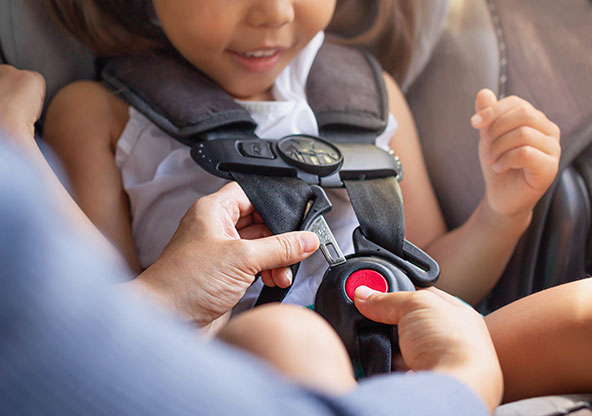Child Car Seat Safety: Tips to Protect Your Little Ones in the Car
This article was created in collaboration with several CHRISTUS Health providers.
Child Passenger Safety Week, observed in September, serves as a reminder of the critical importance of properly restraining kids in vehicles.
Motor vehicle crashes remain a concerning leading cause of death among children. Despite the general assumption that children are usually securely buckled up, the National Highway Traffic Safety Administration (NHTSA) sheds light on a troubling statistic: a staggering 46% of all car seats are misused.
It is the parent's responsibility to ensure the safety of little ones during car rides. Here are some essential tips and guidelines provided by the Texas Department of Public Safety and other reputable sources to keep our children safe while traveling in cars.
Age-Appropriate Car Seat System
According to Texas law, all children under eight must use an appropriate child safety seat system while riding in a passenger vehicle, unless they are taller than 4' 9". The car seat system must be installed correctly following the manufacturer's instructions, which includes tethering and anchoring the seat. By complying with this law, we can significantly reduce the risk of injuries in the event of a crash.
Choosing the Right Car Seat
Selecting the right car seat involves considering your child's age, height, weight, and developmental level. Follow the car seat manufacturer's guidelines and your vehicle's owner's manual for proper installation and usage.
Rear-Facing Car Seats
Experts recommend keeping children rear-facing for as long as possible, at least until they reach two years of age. Rear-facing car seats provide superior protection for an infant’s vulnerable head, neck, and spine during collisions. Read your manufacturer’s instructions on proper installation and ensure the car seat and your child are securely buckled before driving.
Remember never to place a rear-facing car seat in the front seat with an active airbag, as it is much more dangerous.
For harnessed seats, the chest clip should be positioned at the armpit level, not on the abdomen, to prevent internal injuries during an accident. Make sure the harness straps are snug. You shouldn’t be able to pinch extra material. A properly adjusted harness keeps your child flat against the back of the seat.
Front-Facing Car Seats
Front-facing car seats are suitable for children who have outgrown their rear-facing seats and are at least two years old or meet the height and weight requirements set by the car seat's manufacturer. Front-facing car seats use a harness system that secures the child in place, providing protection during collisions. As children continue to grow, front-facing car seats provide the necessary support for their developing neck and spine. Parents must adhere to the manufacturer's guidelines and their vehicle's owner manual for proper installation, harness adjustment, and usage to ensure the utmost safety and peace of mind while traveling with little ones.
Booster Seats for Older Kids
Children who are eight years old but not yet 4' 9" should continue using an appropriate car seat, such as a booster seat, until they can safely wear an adult seat belt. Booster seats help ensure that the seat belt fits correctly, reducing the risk of injuries in a crash. A booster seat or seat adjustment is likely needed if the seat belt lays across the neck or slips off the shoulder.
Riding in the Backseat
Children under the age of 13 should not ride in the front seat of a car. The backseat is the safest place for children to travel, as it minimizes their exposure to potential hazards like airbags and frontal collisions.
Learn More
Common Mistakes to Avoid
It’s easy to get negligent in ensuring your children are properly buckled up every time they get in a vehicle. Avoid these common mistakes to ensure your child's safety—every car ride.
- Switching to forward-facing too early: Keep infants and toddlers in rear-facing car seats until at least two years old or until they reach the seat's weight and height limits.
- Leaving straps too loose: Secure the car seat firmly in place and tighten the harness straps properly to avoid excess movement.
- Incorrect positioning of the chest clip: Place the chest clip at armpit level, not on the abdomen, for optimal restraint.
- Using the wrong harness slots: Use the harness slots that are at or just below your child's shoulders while in the rear-facing position.
- Neglecting to fully secure the car seat: Most car seats for infants and toddlers should be properly tethered and harnessed to the seat. Always refer to the manufacturer’s instructions.
Expert Car Seat Assistance and Registration
Ensure your child’s car seat is the correct fit and is correctly installed by scheduling an inspection by a certified technician.
During the inspection, a certified technician will thoroughly assess your car seat's installation, ensuring it is securely and correctly fastened. They will also verify that the harness fits snugly, making sure your child is properly restrained.
A technician can also answer any questions you may have about using the car seat and provide valuable tips for safe travel. This expert assistance not only enhances your child's safety but also provides you with peace of mind knowing you have taken all necessary precautions.
The NHTSA offers an excellent resource for finding inspection stations and certified technicians near you. Locate a nearby inspection station and schedule an appointment with a knowledgeable professional on their website: https://www.nhtsa.gov/equipment/car-seats-and-booster-seats#installation-help-inspection
In addition to getting your car seat inspected, you can also register your car seat to protect your passengers further. Manufacturers occasionally issue recalls to address potential defects or safety issues, and staying informed about these recalls is crucial to ensure your child's continued protection. Registering your car seat is a simple process that can usually be completed online, and it allows you to be promptly notified if any safety-related issues arise.


